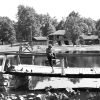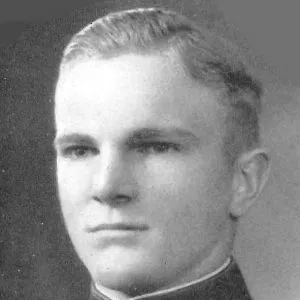calsfoundation@cals.org
Raymond Henry Bass (1910–1997)
Raymond Henry Bass was an Olympic gold medalist, Gymnastics Hall of Fame honoree, and decorated World War II hero who rose to the rank of rear admiral in the U.S. Navy.
Raymond Henry Bass was born on January 15, 1910, in Chambersville (Calhoun County) to Henry L. Bass and Maude Wise Bass. He entered the U.S. Naval Academy at Annapolis, Maryland, in 1927 and was recruited for the gymnastics team. He was coached by Lou Mang, who had developed an innovative rope-climbing technique stressing rhythm and balance. According to an Olympics biography of Bass, he was a boxer and wrestler at the Naval Academy before joining the gymnastics team and was nicknamed “Benny” by his classmates due to a resemblance to professional boxer Benny Leonard.
After graduating in 1931, Bass was part of the U.S. Olympic team competing in the 1932 Summer Olympics in Los Angeles, California. He won the gold medal in rope-climbing, ascending an eight-meter rope in 6.7 seconds. Two of his Annapolis classmates won the silver and bronze medals with times of 6.8 and 6.9 seconds. Rope-climbing was eliminated as an Olympic event after 1932, and Bass later said, “I presume they voted out the rope climb because they didn’t care for the U.S. getting 1-2-3 as long as Lou Mang was around.” The rope Bass climbed was later placed in the Naval Academy gymnasium, wrapped around an Olympic shield.
Bass married Marjorie Mae Hart of Los Angeles in the Naval Academy chapel on July 9, 1934; they had two sons and a daughter.
As World War II broke out, Bass took command of the USS Plunger and proved to be an aggressive submariner. He was awarded the Navy Cross, the navy’s second-highest award for valor, and a Navy and Marine Corps Medal for an action in the Plunger’s sixth combat patrol in April and May 1943, in which the submarine attacked an escorted convoy of five ships, sinking three vessels and heavily damaging two others. He received a Silver Star for an action in which the Plunger “succeeded in sinking an important amount of enemy shipping despite vigorous anti-submarine measures on the part of the enemy.”
Bass was awarded the Legion of Merit for actions during the Plunger’s ninth patrol between November 14 and December 13, 1943, when the submarine spent considerable time on the surface looking for downed American aviators. On November 22, “while making a difficult approach in extremely rough seas” in the course of rescuing a pilot, the submarine was strafed by a Japanese Zero, injuring an officer and five seamen. He received a second Legion of Merit after “a very important special mission was successfully accomplished,” after which the Plunger sank a 600-ton enemy ship.
Lieutenant Commander Bass received a second Navy Cross after the Plunger’s tenth combat patrol, lasting from January 14 to March 8, 1944, during which the submarine pursued heavily guarded Japanese convoys and sank four ships weighing 22,500 tons despite relentless air and surface counterattacks. “Although severely depth-charged during thorough and persistent counterattacks, he courageously and expertly directed his vessel and succeeded in bringing her to port without serious injury to ship or crew,” according to the medal citation.
The Plunger also received a Navy Unit Citation for a sixty-five-hour running battle in which the submarine damaged several vessels with torpedoes and sank one ship using its three-inch deck gun.
Bass had taken the Plunger on two missions in the Sea of Japan and was starting on a third when the war ended. Instead, he led a convoy of twelve submarines into Tokyo Bay to take part in the Japanese surrender ceremonies.
After World War II, Bass commanded a fleet of fifty-five submarines in the Atlantic Ocean; the troop transport USS Rockbridge in the Mediterranean Sea; and the USS Bremerton, a heavy cruiser, in the Far East. He retired in 1959 as a rear admiral. That same year, he was in the inaugural group of athletes inducted into the Gymnastics Hall of Fame.
After leaving the navy, Bass, who held master’s degrees in engineering and business administration from the University of California at Los Angeles, worked for Bendix Electrodynamics until 1972, after which he had a twenty-year career in real estate in Glendale, California. He died in Glendale on March 10, 1997, and is buried in Chambersville Cemetery in Calhoun County.
For additional information:
“Biography: BASS, Raymond.” Gymnastics Hall of Fame.” https://usghof.org/files/bio/r_bass/r_bass.html (accessed May 10, 2022).
“Miss Hart Married in Annapolis.” Los Angeles Times, July 10, 1934, p. 22.
Oliver, Myrna. “R. H. Bass; War Hero, Olympic Gold Medalist.” Los Angeles Times, March 14, 1997. Online at https://www.latimes.com/archives/la-xpm-1997-03-14-mn-38185-story.html (accessed May 10, 2022).
“RADM Raymond Henry Bass.” Find-A-Grave. https://www.findagrave.com/memorial/131220333/raymond-henry-bass (accessed May 10, 2022).
“Raymond Bass, 87, Olympic Gymnast and Navy Admiral.” New York Times, March 24, 1997, 7B.
“Raymond Henry Bass.” The Hall of Valor Project. https://valor.militarytimes.com/hero/20202#14815 (accessed May 10, 2022).
“Raymond Henry Bass.” Olympics.com. https://olympics.com/en/athletes/raymond-henry-bass (accessed May 10, 2022).
Mark K. Christ
Central Arkansas Library System








Comments
No comments on this entry yet.